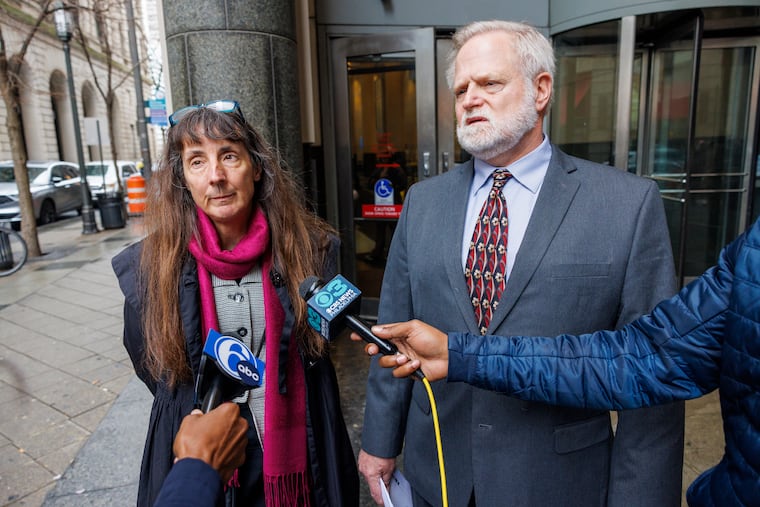Philly judge has dismissed charges against death-row inmate Daniel Gwynn in 1994 arson murder
Gwynn’s exoneration ends a yearslong push from his attorneys to prove that he had given a false confession to Philadelphia police during the 1990s while he was in the midst of a narcotics addiction.

Daniel Gwynn has spent the last 27 years in a Pennsylvania prison, “trapped in a box where the days just tick away,” according to his words posted online by a justice-oriented arts nonprofit.
Gwynn’s anguish comes from decades of claiming that he was wrongly convicted of murder in a 1994 West Philadelphia arson that left one woman dead and others injured.
On Wednesday morning, Common Pleas Court Judge Barbara A. McDermott dismissed first-degree murder, arson, and aggravated assault charges against Gwynn, issuing no ruling on guilt or innocence, but guaranteeing Gwynn’s release from the State Correctional Institution Phoenix in Montgomery County, where Gwynn, 54, has been on death row.
It was not clear Wednesday when Gwynn would be released from prison.
“This was a very decent and long, long, long overdue result,” said Karl Schwartz, Gwynn’s defense lawyer. “We’re very, very happy about it.”
Gwynn’s exoneration, requested by the District Attorney’s Office, ends a yearslong push from his lawyers to prove that he had given a false confession to Philadelphia police while he was in the midst of a narcotics addiction.
Gwynn’s team also challenged the police department’s handling of the witness-identification process, alleging there was reason to believe another person lit the fire that tore through a three-story apartment building on the 4500 block of Chestnut Street that November morning, killing Marsha Smith from smoke inhalation after other occupants jumped from the window.
The motion to drop Gwynn’s charges by the District Attorney’s federal litigation unit signals a continuance of District Attorney Larry Krasner’s pledge to reexamine decades-old cases in which evidence suggests a defendant’s innocence.
David Napiorski, a prosecutor with the federal litigation unit, said there were multiple issues with Gwynn’s confession, including factors that were not supported by physical evidence and that proved its falsehood.
“He said the fire started one way, when we know it started another way,’ Napiorski said. “He said the fire started downstairs, when we know it started upstairs. He said he ran out the front door, when we know the front door was boarded shut.”
More notable was a glaring problem with photo arrays police showed witnesses. According to the District Attorney’s Office, those photos did not feature Gwynn at all.
Still, Napiorski said there was no evidence that police coerced Gwynn’s confession — a different account of the interrogation from Gwynn’s, which was posted publicly by members of Art for Justice.
“I think he was probably terrified, and he was intoxicated, and he probably said whatever he thought they wanted to hear,” Napiorski said.
On Art for Justice’s website, a page sharing Gwynn’s story in his own words details the man’s Philadelphia upbringing during the crack-cocaine epidemic. Gwynn described a history of harassment from police, and said addiction lead him to commit petty crimes to pay for his drug habit in adulthood.
“I developed a bad reputation and was getting blamed for just about everything that happened in the hood,” Gwynn wrote.
Police arrested Gwynn 10 days after the fire that killed Smith. After a jury convicted him on all counts, he was sentenced to death.
Gwynn’s writing suggests that during his interrogation, “Detectives took advantage of my addled brain. They lied, manipulated information and made gestured threats to hurt me.” Gwynn said his confession was given in part by fear from past interactions with police.
Despite spending nearly 30 years awaiting possible death, prison allowed Gwynn to develop his skills as a painter, which he described as a form of therapy on his Art for Justice page. Many of Gwynn’s paintings featured on the page relate to his experiences in the criminal justice system.
“I think Daniel is pleading for a greater humanity, where justice is fair for everybody,” said Ann Marie Kirk, Art for Justice’s director who has corresponded with Gwynn since 2001. “He’s also telling the stories of our society.”
With the dismissal of the charges against Gwynn, Napiorski said he did not know whether the Philadelphia Police Department would reopen Smith’s murder investigation.
Both prosecutors and Gwynn’s defense agreed that another man likely doused the third and fourth floors of the West Philadelphia apartment with gasoline Nov. 19, 1994 — information that, withheld from Gwynn, violated his constitutional rights, according to the District Attorney’s Office.
Smith and several other people described in court records as squatters were awakened to shouts of fire at around 6 a.m. that day. Finding that the gasoline had been poured so that fire blocked the stairwell, the remaining occupants escaped by jumping from a window onto a pile of trash.
Smith, suffering from panic, was unable to exit, court records said.
A man was alleged to have visited Smith and another squatter at the building the day before, court records said. After an altercation that left Smith with a bloody injury to the mouth, the perpetrator was allegedly heard saying “I’ll get you one way or another, all of you,” among other threats, as he departed.
Napiorski said Wednesday that previously undisclosed evidenced suggested that a man already serving a life sentence for a separate murder conviction is likely the suspect. According to Napiorski, the occupants of the burned apartment complex had testified against this person — whose identity he did not share — several days before the blaze, and were threatened for their involvement.